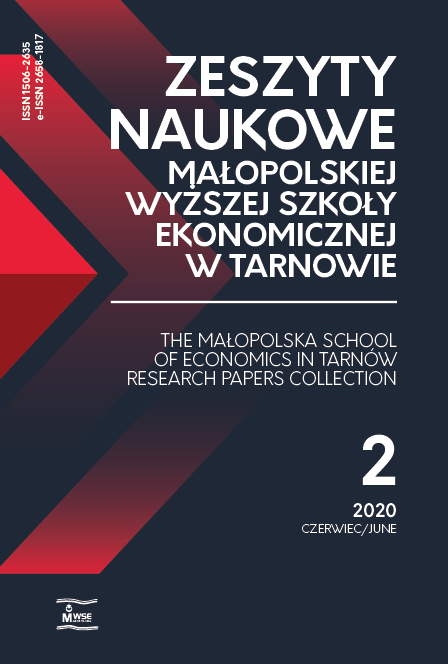Abstract
This paper outlines selected concepts, factors and instruments, which may be used for motivating employees to work. It was found that work motivation depends on both the employee willingness and competences, their individual characteristics, as well as on the motivational characteristics of the work performed. The concept of work motivation therefore applies to the employee and to the company alike, becoming one of the components of their work potential. The motivational potential, coupled with the skill potential of the work, as well as working time, constitute work potential, which can be determined, then shaped and raised as appropriate. The main objective of this paper is to outline the concept of a system of evaluation of motivational potential of work in a company and the results of empirical studies. The identification and evaluation of motivational potential of work in the surveyed company was selected as the main research problem. The practical aim of the study was to identify the gap in the motivational potential of work, which constitutes the difference between the desired level of motivational potential of work and the actual level determined in the company. When measuring the motivation gap, the state of discrepancy between presented values is determined and the directions and ways of bridging this gap are indicated. To achieve the objectives of the study and verification of the hypotheses, the researchers used literature analysis, influence factor analysis, survey, expert study, case study and categorization technique. The use of these methodologies for evaluating the motivational potential of work in practice, or—more precisely—the information gathered thanks to these methodologies, can constitute the basis for modelling the growth capacity of a company and for recognizing the managerial pragmatism of the company in this area.
References
Adair, J. (2001). Budowanie zespołu. Jak stworzyć dynamiczny zespół. Transl. by E. Czerwińska. Warszawa: Studio Emka. ISBN 8388607960.
View in Google Scholar
Armstrong, M. (2005). Zarządzanie zasobami ludzkimi. 3rd ed. Transl. by A. Hędrzak et al. Kraków: Oficyna Ekonomiczna. ISBN 8389355884.
View in Google Scholar
Asanger, R. R. et al. (eds.). (2009). Der Brockhaus Psychologie: Fühlen, Denken und Verhalten verstehen. Mannheim and Leipzig: F. A. Brockhaus. ISBN 9783765305924.
View in Google Scholar
Bandura, A. (2007). Teoria społecznego uczenia się. Transl. by J. Kowalczewska, J. Radzicki. Warszawa: Wydawnictwo Naukowe PWN. ISBN 9788301153021.
View in Google Scholar
Białas, S. (2013). Zarządzanie zasobami ludzkimi w otoczeniu międzynarodowym: kulturowe uwarunkowania. Warszawa: Wydawnictwo Naukowe PWN. ISBN 9788301171803.
View in Google Scholar
Cofer, Ch. N., Appley, M. H. (1972). Motywacja: teoria i badania. Warszawa: Państwowe Wydawnictwo Naukowe.
View in Google Scholar
Czerniachowicz, B. (2014). Rola potencjału pracy w kształtowaniu innowacyjności przedsiębiorstwa. Zeszyty Naukowe Uniwersytetu Szczecińskiego. Studia i Prace Wydziału Nauk Ekonomicznych i Zarządzania, 1(38), 127–136.
View in Google Scholar
Gableta, M. (1998). Potencjał pracy i jego znaczenie. In: M. Gableta (ed.). Potencjał pracy w przedsiębiorstwie: kształtowanie i wykorzystanie (pp. 9–18). Wrocław: Wydawnictwo Akademii Ekonomicznej we Wrocławiu. ISBN 8370112897.
View in Google Scholar
Gagné, M., Deci, E. L. (2005). Self-determination theory and work motivation. Journal of Organizational Behavior, 26, 331–362. DOI: 10.1002/job.322.
View in Google Scholar
Griffin, R. W. (2018). Podstawy zarządzania organizacjami. Transl. by A. Jankowiak. Warszawa: Wydawnictwo Naukowe PWN. ISBN 9788301194802.
View in Google Scholar
Kozińska, A., Szybisz, J. (2004). Jak nie demotywować pracowników. In: S. Borkowska (ed.). Motywować skutecznie (pp. 28–32). Warszawa: Instytut Pracy i Spraw Socjalnych. ISBN 8387890561.
View in Google Scholar
Kozioł, L. (2011). Trychotomy of motivating factors in the workplace. Concept outline. Zeszyty Naukowe Małopolskiej Wyższej Szkoły Ekonomicznej w Tarnowie, 19(2), 45–54. DOI: 10.25944/znmwse.2011.02.4554.
View in Google Scholar
Kozioł, L., Kozioł, M. (2016). Wykorzystanie koncepcji trychotomii czynników motywacji turystycznej w procesie zarządzania przez tworzenie wartości dla klienta. Zeszyty Naukowe Małopolskiej Wyższej Szkoły Ekonomicznej w Tarnowie, 30(2), 99–116. DOI: 10.25944/znmwse.2016.02.99116.
View in Google Scholar
Madsen, K. B. (1980). Współczesne teorie motywacji: naukoznawcza analiza porównawcza. Transl. by A. Jakubczyk, M. Łapiński, T. Szustrowa. Warszawa: Państwowe Wydawnictwo Naukowe. ISBN 8301004029.
View in Google Scholar
Penc, J. (1996). Motywowanie w zarządzaniu. Kraków: Wydawnictwo Profesjonalnej Szkoły Biznesu. ISBN 8385441204.
View in Google Scholar
Pietroń-Pyszczek, A. (2007). Motywowanie pracowników: wskazówki dla menedżerów. Wrocław: Wydawnictwo Marina. ISBN 9788392413820.
View in Google Scholar
Reilly, P., Williams, T. (2009). Strategiczne zarządzanie zasobami ludzkimi: rozwijanie potencjału organizacji dzięki funkcji personalnej. Transl. by K. Wacowska. Kraków: Oficyna a Wolters Kluwer business. ISBN 9788375266832.
View in Google Scholar
Rheinberg, F. (2006). Psychologia motywacji. Transl. by J. Zychowicz. Kraków: WAM. ISBN 8373186409.
View in Google Scholar
Ryan, R. M., Deci, E. L. (2000). Intrinsic and extrinsic motivations: Classic definitions and new directions. Contemporary Educational Psychology, 25(1), 54–67. DOI: 10.1006/ceps.1999.1020.
View in Google Scholar
Rybak, M. (2000). Rozwój potencjału pracy. In: A. Sajkiewicz (ed.). Zasoby ludzkie w firmie: organizacja, kierowanie, ekonomika (pp. 245–253). Warszawa: Poltext. ISBN 8386890770.
View in Google Scholar
Sajkiewicz, A. (1995). Potencjał pracy w organizacji. In: A. Sajkiewicz (ed.). Zarządzanie potencjałem pracy (pp. 4–11). Warszawa: Oficyna Wydawnicza Szkoły Głównej Handlowej.
View in Google Scholar
Smoleń, R. (2020). Assessment of the motivational potential of work in a company—research results. Zeszyty Naukowe Małopolskiej Wyższej Szkoły Ekonomicznej w Tarnowie, 45(1), 107–121. DOI: 10.25944/znmwse.2020.01.107121.
View in Google Scholar
Smoleński, S. (1999). Menedżer przełomu wieków. Bydgoszcz: TNOiK and Oficyna Wydawnicza Ośrodka Postępu Organizacyjnego. ISBN 8387636630.
View in Google Scholar
Stelmach, W. (2005). Ciemne strony kierowania. Warszawa: Placet. ISBN 8385428992.
View in Google Scholar
Steward, D. M. (ed.). (2002). Praktyka kierowania. Warszawa: Polskie Wydawnictwo Ekonomiczne. ISBN 8320814049.
View in Google Scholar
Waszczak, S. (2010). Miejsce motywacji wewnętrznej wśród rodzajów motywacji i sposobów motywowania. In: A. Lipka, M. Król, S. Waszczak, A. Winnicka-Wejs. Kształtowanie motywacji wewnętrznej: koszty jakości i ryzyko (pp. 13–25). Warszawa: Difin. ISBN 9788376411811.
View in Google Scholar

This work is licensed under a Creative Commons Attribution-NonCommercial-NoDerivatives 4.0 International License.

